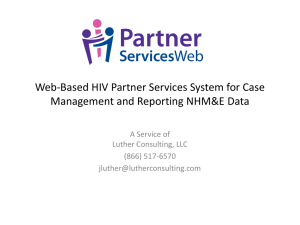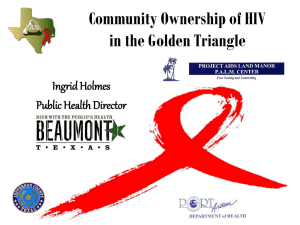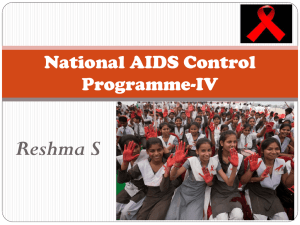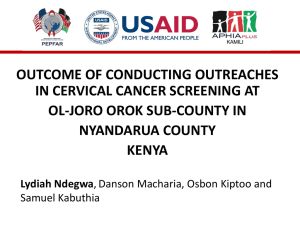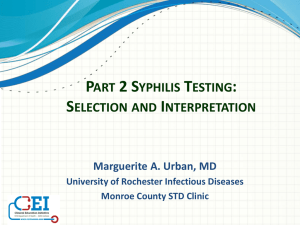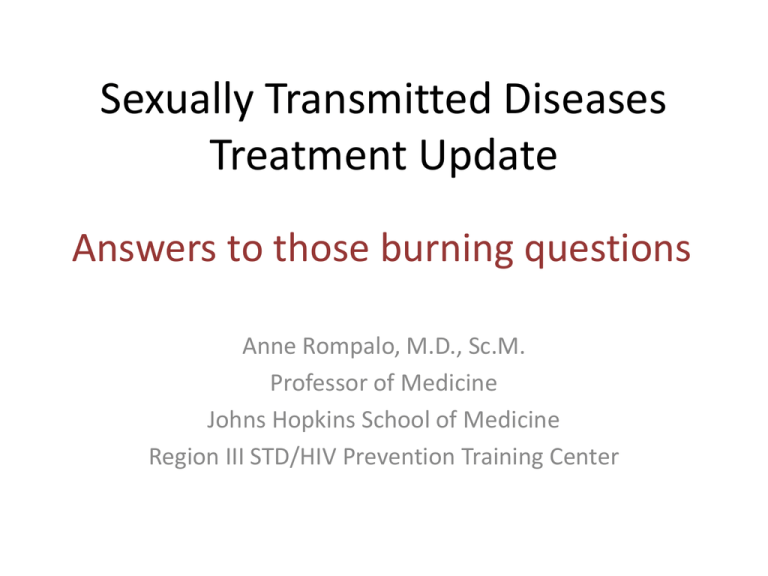
Sexually Transmitted Diseases
Treatment Update
Answers to those burning questions
Anne Rompalo, M.D., Sc.M.
Professor of Medicine
Johns Hopkins School of Medicine
Region III STD/HIV Prevention Training Center
Conflict of Interest
• None
Objectives
By the end of this lecture, you should be able to:
• Identify and elicit risk behaviors for STIs
• Choose appropriate tests for common STI screening
and diagnosis
• Administer recommended therapy for common STIs
• Provide guidance and referrals for STI prevention
Clinical Prevention Guidance
• High intensity behavioral counseling (USPSTF)
• Pre-exposure vaccination- HAV, HBV, HPV
• Condoms
– CDC fact sheet; female nitrile condom
• Microbicide trials
– Trial updates at www.microbicide.org
• Male circumcision may reduce acquisition of some
STI (HPV, genital HSV)
•Overall HIV incidence=
5.6/100 women-years
tenofovir vs. 9.1/100 women
years in placebo arm
•In high adherers (>80% gel
adherence) HIV incidence
was 54% lower
Clinical Prevention Guidance
• Preexposure prophylaxis for HIV/STI
– ART has potential to impact HIV transmission
– No data PrEP for STD prevention
• Postexposure prophylaxis for HIV/STI
– genital hygiene methods (douching, washing after sexual
exposure) ineffective and may increase risk of BV, some
STI, and HIV
• CT, GC rescreening
Prevention Methods
Male Condoms
• Correct/consistent latex condom use- highly effective
in preventing sexual transmission of HIV; reduced
risk- CT, GC, trichomoniasis
• May reduce risk of HSV-2 transmission
• May reduce risk of genital warts, cervical cancer
– Higher rates of CIN regression, HPV clearance, penile
lesions
– Protective- HPV acquisition (newly sexually active women)
Syndromes
Urethritis
• GC (5-20%), CT (15-40%)
• Mycoplasma genitalium
– 15-25% of NGU
• Trichomonas vaginalis 5-20% of
NGU
• Ureaplasma urealyticum (UU)
– cumulative data insufficient
• CT or MG <5 PMNs (10-30% CT or
MG)
• Diagnostic tools not available Rx
CT/GC
NGU Pathogens
Schwebke JR et al; STI CTG
NGU Treatment
• Current drug regimens are adequate for majority of
bacterial NGU
• Azithromycin > doxcycline for M. genitalium (82% vs
39%)
• Cost considerations and lack of public health impact
data for MG insufficient to demote doxycycline to
alternative agent
Persistent/Recurrent NGU Management
• Recurrence
– Re-exposure from untreated partners
– T. vaginalis and M. genitalium
– U. ureaplasma may account for some failures
• Urologic exam usually doesn’t reveal specific etiology
• 50% chronic nonbacterial prostatis/chronic pelvic pain
syndrome have evidence of urethritis without pathogen
Mycoplasma genitalium
• Association with acute or persistent NGU
– No role in male infertility (limited data)
• Conflicting/insufficient evidence for cervicitis, PID,
infertility, ectopic pregnancy, adverse birth outcomes
• AZM superior to doxy for MG urethritis
– Extended duration AZM not superior to single dose
– In vitro resistance to AZM and doxycycline
• Moxifloxacin for persistent NGU
Epididymitis
• Chronic infectious epididymitis (M tb)
• Ceftriaxone + doxycycline for initial tx
– quinolone if GC – (cx or NAAT) or infection likely
caused by enteric organism
• Ceftriaxone + quinolone
– Risk for both sexually transmitted and enteric
organisms (MSM-insertive anal intercourse)
Cervicitis
• CT/GC NAATs-vaginal, cervical, urine
• Case reports of treatment of cervical ectopy,
but no new antimicrobial treatment trial
information
• Research is needed on the etiology of
persistent cervicitis including the potential
role of Mycoplasma genitalium
Cervicitis
Chlamydia
• Primary focus of screening efforts to detect
and prevent complications in women
• Selective male screening- (adolescent clinics,
corrections, national job training program, <
30 yrs, STD, military)
• Retest women/men 3 mo post tx
– CT testing in third trimester (reinfection)
PID
• Some association between MG
– Insufficient data to support testing/tx MG
• Emergence of QRNG
– Quinolones not recommended
– Parenteral tx not feasible- prevalence/individual risk low;
naat+ consider azi 2 gm + quinolone+/- metronidazole
• Short term success-ceftriaxone 250 mg IM
+azithromycin 1gm qwk x2
• Insufficient evidence to warrant removal of IUD
Gonorrhea
• Screen sexually active women at increased risk <25
years, previous GC or other STIs, new or multiple
partners, inconsistent condoms, CSW, drug use
(USPSTF)
• No screening in men or women at low risk of
infection (USPSTF)
• Retest women/men 3 mo after tx
Gonorrhea
• NAAT sensitivity in genital/non-genital sites
superior to culture (variation in NAATs, crossreaction)
Historical perspective on antimicrobial resistance in the United States.QRNG = quinoloneresistant Neisseria gonorrhoeae; MSM = men who have sex with men.
Workowski K A et al. Ann Intern Med 2008;148:606-613
©2008 by American College of Physicians
The geography of resistance:
Global patterns 1990s 2000s
1990s
1980s
QRNG
1990s
QRNG
appears in
Rwanda
appearsQRNG
in
appears in SE
India
Asia
1991
QRNG CDC stops
recommending
appears
on
Quinolones
West Coast
QRNG
appears in
Hawaii
1984
QRNG
appears in
Australia
Gonorrhea
• The gonococcus has evolved a number of different
resistance determinants over time and multidrugresistant GC now exist
• GC clinical failures after treatment with oral
cephalosporins have been reported – these cases are
still treatable with high-dose ceftriaxone
• There are no new anti-gonococcal drugs on the horizon
and singe-dose regimens may need to be replaces with
extended regimens or multidrug regimens
• Public health approaches to GC control need to be
enhanced to reduce global burden
Gonorrhea
• Ceftriaxone 250 mg IM preferred regimen
• Ceftriaxone efficacy (anogenital)
– 250 mg = 99.2% ( L95%CI = 98.8%)
– Geographic distribution in vitro decreased susceptability, ceftriaxone
failures, enhanced pharyngeal efficacy, consistent guidance at all
anatomic sites
• Cefpodoxime 400 mg alternative regimen
– Acceptable efficacy at urogenital; poor at oropharyngeal
– Cefpodoxime MIC > cefixime MIC
Oropharyngeal GC:
a silent cause for concern
• Is clinically silent with less than 10% presenting with
“sore throat”
• Commonly occurs in risk groups without concurrent
anogenital infection
• Transmission is efficient by both fellatio and insertive
oro-anal contact
• Diagnosis by culture is insensitive and should be
replaced by NAATs; culture remains important for
surveillance of antimicrobial resistance
• Isolates with multiple antibiotic resistance can emerge
• Treatment failure is more likely, and a test of cure is
essential
Oropharyngeal GC Treatment
• Ceftriaxone efficacy for oropharyngeal GC acceptable
– 125 mg = 94.1% ( L95%CI = 85.6%)
– 250 mg = 98.9% ( L95%CI = 94.0%)
• Limited efficacy of oral cephalosporins (poor penetration)
– Cefpodoxime 400 mg = 70.3%, 26/37 patients (Hall)
– Cefixime 400 mg = 88.9%, 8/9 (McMillan)
– Cefixime + azithro 1 g = 100%, 36/36 (McMillan)
• Azithromycin 2 gm = 95%, 20/21 (L95%CI=76.2%) (Dan)
• + oral exposure- regimen with enhanced pharygneal efficacy
GC Treatment Recommendations
• Recommended regimens
– Ceftriaxone 250 mg IM
– Cefixime 400 mg PO
• Alternatives
– Cefpodoxime 400 mg
-Cefuroxime axetil 1 g (marginal)
– Azithromycin 2 g (PCN allergy)
Co-treat for Chlamydia
• Co-treatment might hinder the development
of antimicrobial resistance
– GC dual treatment (oral cephalo +azi) may
enhance oropharyngeal tx response
Cephalosporin GC Rx Failures
• Treatment failure or in vitro resistance
–
–
–
–
–
infectious disease consultation
culture and susceptibility
Rx 250 mg of ceftriaxone IM
ensure partner tx
report to CDC via state or local public health authorities
Genital, Perianal, Anal Ulcers
Evaluation
• History and physical examination often inaccurate
• Majority due to HSV or syphilis
– Less common chancroid (remove recommendation for testing)
– noninfectious (yeast, aphthi, fixed drug eruption, psoriasis)
• Serologic test for syphilis
• Diagnostic evaluation for HSV (culture, PCR)
• Treat for dx most likely based on clinical/epidemiology
• Biopsy if uncertain
Syphilis
• Diagnostic considerations
– No commerically available Tp detection tests
– Management of treponemal+ RPR –
– >20 WBC in CSF (HIV+) may improve specificity of
NS diagnosis
– CSF FTA negative predictive value for NS
Syphilis
• No enhanced efficacy of additional BPG or
amoxicillin in early syphilis (HIV+/-)
• Failure of RPR to decline 4x in 6-12 mo after 1o
or 2o may indicate tx failure
• Azithromycin used with caution when BPG or
doxycycline not feasible
– Resistance
– No use in MSM or pregnancy
Syphilis and HIV
• ART may improve clinical outcomes in HIV+
• HIV+ with syphilis of any stage and neurologic sx
should undergo CSF exam
• Majority of HIV+ respond standard tx
– Clinical/CSF abnormalities c/w NS have been shown
CD4<350 and/or RPR >1:32; however if asx, no data that
CSF exam associated with improved outcomes
Syphilis in Pregnancy and Congenital
Syphilis
• Treponemal screening performed with reflex
nontreponemal test
• Oral step-wise pcn dose challenge or skin testing may
be helpful in identifying women at risk for acute
allergy
• Erythromycin or azithromycin does not reliably cure
maternal infection or infected fetus
• Insufficient data on ceftriaxone for treatment of
maternal infection and prevention of CS
Syphilis Laboratory testing and the EIA
dilemma
• Two licensed tests for screening and confirmation
– Trinity Captia Syphilis G (sonicated treponemes)
– Trepchek G (cloned antigens)
• Increased use of treponemal EIA for screening;
clinical management problems
• Quantitative non-treponemal testing to guide
patient management; if test is negative, perform a
second treponemal test to determine reactivity
Recommendations for laboratory syphilis testing algorithm with
treponemal EIA (or CIA) as initial test
A1 (EIA or CIA)
A1 –
A1+
Negative for syphilis
A2
(quantitative nontreponemal test
i.e. RPR)
A1+ A2+
Consistent with syphilis
A1+ A2 –
(past or current)
A3
Treponemal test that uses a
different Ag platform from A1
(i.e. TPPA, FTA-ABS)
A1+ A2 - A3+
A1+ A2 – A3 -
Possible syphilis
Unconfirmed EIA
HSV
• IgM testing not useful
• Suppressive antivirals does not abrogate increased
risk of HIV acquisition
• Episodic tx- acyclovir/valacyclovir equally effective;
famciclovir less effective
• Famciclovir 500 mg x1, 250 mg bid x 2 d episodic
• Acyclovir resistance
• Stronger recommendation for antiviral tx in late
pregnancy with sx HSV
Genital Herpes: Serologic Tests
• Several licensed type-specific tests (glycoprotein G)
• HerpeSelect EIA/immunoblot, and point-of-care tests (BioKit
HSV2, SureVue HSV2)-sensitivities 80-98%, specificities > 96%
• Non gG-based assays are still on market, less accurate
• Potential uses:
– culture-negative ulcers with recurrent/atypical lesions
– clinical dx without lab confirmation
– Partners
• Not indicated for general population screening
• Some experts suggest use as part of comprehensive STI
evaluation
– persons with multiple sex partners, HIV, MSM
HSV Treatment
• Valacyclovir 500 mg qd decreases the rate of HSV-2
transmission in discordant heterosexual couples
– Consider treatment as strategy to prevent transmission
(avoid sex with lesions, condoms)
– Findings likely apply to MSM, multiple partners,
asymptomatic HSV2
Lymphogranuloma venereum
• Proctitis presentation among HIV+ MSM
• Diagnosis
– Genital or lymph node aspirates-culture, DFA, nucleic acid
detection (CLIA validation)
– Genotyping required for determining LGV strains
– Serology can support (CF > 1:64), not validated for proctitis
• Empiric Rx warranted for appropriate clinical
syndrome
– Doxycycline 100 mg PO bid x 21 d
– ?? Azithromycin 1 g PO q wk x 3 wks
Scabies/Pediculosis
• Permethrin superior to crotamiton
• Combined tx for crusted scabies oral/ topical
scabicide
– Some specialists recommend combined treatment
with a topical scabicide and repeated treatment with
oral ivermectin 200 ug/kg on days 1,2,8,9 and
15.Additional treatment on days 22 and 29 may be
required for severe cases. Ivermectin should be
combined with the application of either 5% topical
benzyl benzoate or 5% topical permethrin (full body
application to be repeated daily for 7 days then 2x
weekly until discharge or cure).
• Emerging resistance to all pediculicides except
malathion
Bacterial Vaginosis
• Fastidious/uncultivated anaerobes
• BV specific organisms ~antimicrobial resistance
– Baseline organisms ?risk of failure
• Alternative regimen
– Tinidazole 2 g qd x 3 or 1 g qd x 3
• Management of recurrences
• USPSTF- insufficient evidence to support screening
high risk pregnant women; against screening in low
risk
Trichomoniasis
• Screening- vaginal dc or high risk
– Aptima TV analyte specific reagants
– Consider rescreen women ( HIV-/HIV+) at 3 mo
• NAAT preferred diagnostic in men
• Antimicrobial resistance
– 5-10% estimated prevalence
– No data to guide tx of male partners of tx failure
• Metronidazole 500 mg bid x 7 or tinidazole 2 gm
• Interaction HIV~Trichomoniasis
– Screening at entry into HIV care; rescreen
– Tx 500 mg bid x 7 days
HPV/Genital Warts
• Counseling messages
– Oral transmission
• Clarification on use of HPV testing
• GW treatment
– Sinecatechins ointment (15%) as a patientapplied
– Vitiligo side effect of imiquimod
• HPV vaccine
– Emphasis on the difference between bivalent and
quadrivalent HPV vaccine for genital wart prevention
New treatment for genital warts?
• A new therapeutic modality is 15%
sinecatechins ointment (Veregen®)
– A mixture of 8 catechins which are the major
polyphenols found in green tea leaves
– It is applies three times daily until complete
clearance of all warts or for up to 16 weeks
– 3 RCT comparing it to placebo:
• Clearance 57% vs 34% placebo; 53% vs 37% placebo;
one RCT showed better efficacy in men (61% vs 41%
placebo) versus women (58% vs. 34% placebo
clearance)
– Side effects: erythema, itching, pain, ulceration,
edema, induration and vesicular rash
Cervical Cancer Screening
• Clarify indication for high risk HPV testing
• HR HPV testing not indicated
–
–
–
–
+/- vaccinate; STD screening for HPV
Triage of LSIL
Age <21 yr
Primary cervical cancer screening only
• Counseling messages
–
–
–
–
Purpose of screening
Normal pap/+HR HPV test
Disclosure to sex partner
Prevention measures- condoms, vaccine
Anal Cancer Screening
• Increased incidence of anal cancer in HIV+ MSM,
some specialists recommend screening for anal SIL
• Limited data on
–
–
–
–
the natural history of anal intraepithelial neoplasia,
the reliability of screening methods,
the response to treatments,
programmatic considerations
• More data are needed before screening for anal SIL
can be recommended
Hepatitis A
• Hepatitis A - international travelers,
household/sex contacts, non-household
contacts (e.g., play, daycare), IVDA
• Post exposure- hepatitis A vaccine or IG (0.02
mL/kg) based on limited comparative data (no
data >40 yr, medical conditions)
Hepatitis B
• Premastication as source of infection
• HBV vaccine should be offered to all
unvaccinated persons attending STD clinics
and persons seeking STD tx (other settings)
• HBV vaccine (hemodialysis dose)
recommended in HIV+ OI Guidelines
Hepatitis C
• Sexual transmission of HCV (syphilis, LGV)
• HCV serology at baseline HIV visit
– Acute HCV- monitor LFTs
• Unprotected sexual contact may facilitate
spread of HCV (semen); barrier precautions
discussed
Sexual Assault
in Children
• STI screening in children should be independent of
symptoms (Giradet et al, Pediatrics 2009)
• Diagnostic evaluation
– CT NAATs (SDA,TMA) on vaginal swabs/urine in girls; +
specimens retained for additional testing
– GC NAATs test dependent; potential cross-reaction between other
Neisseria species/commensals (N. meningitidis, N. sicca, N. lactamica,
N. cinerea, Moraxella catarrhalis)
– Data insufficient for extragenital NAAT in girls
– Data insufficient for CT/GC NAATs at any site for boys
– HPV infection/mode remains controversial
Sexual Assault in Adults
• CT/GC NAATs -any site of penetration/ attempt
• Routine preventive therapy as follow-up poor
• HIV, hepatitis B, syphilis testing individualized
–
–
–
–
Test results likely represent prevalent STIs
Some centers have opted to stop STI testing
Likely will not impact decision to provide prophylactic Rx
Testing costs may be patient’s responsibility

